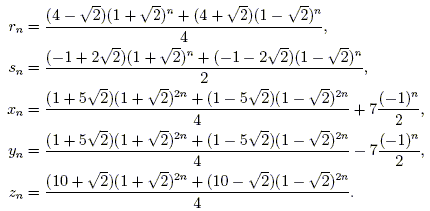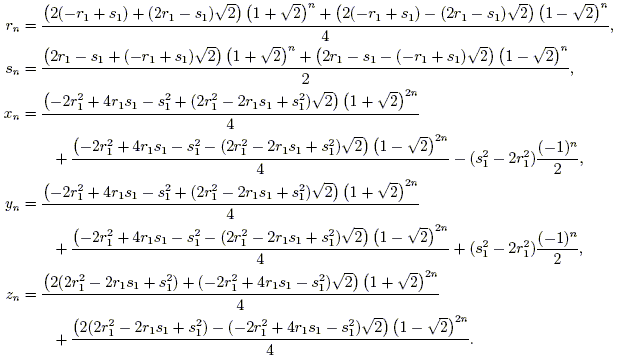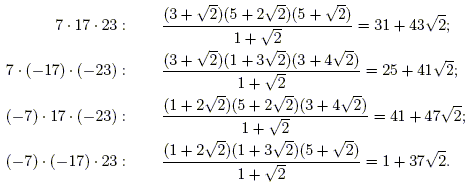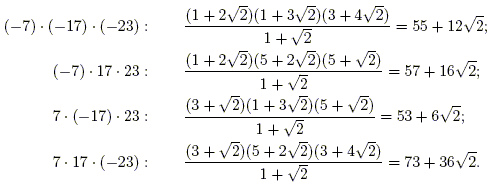III. Counting Triples
Definition Two triples are siblings if they have a common hypotenuse.
The first such pair of primitive triples stem from the hypotenuse 65 (332 + 562 = 632 + 162 = 652):
There are also primitive siblings of the hypotenuse 85:
If we search larger numbers, we can find larger sets of siblings. There are, for example, four primitive triples with hypotenuse 1105:
| x | y | z | r | s
| | 47 | 1104 | 1105 | 23 | 1
| | 817 | 744 | 1105 | 12 | 19
| | 943 | 576 | 1105 | 9 | 23
| | 1073 | 264 | 1105 | 4 | 29
|
In general, the number of primitive Pythagorean triples of hypotenuse n is dependent on the number of prime factors of n that are congruent to 1 modulo 4. It turns out that only powers of 2 appear as these numbers. The numbers in the sequence 5, 65, 1105, 32045, 1185665, 48612265, 2576450045,... are the smallest hypotenuses that harbor 1, 2, 4, 8, 16, 32, 64,... primitive Pythagorean triples. The terms are given by multiplying successive primes that satisfy p ≡ 1 mod 4:
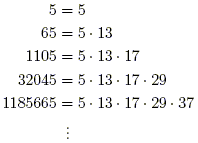
The hypotenuse 32045 has eight primitive triples:
| x | y | z | r | s
| | 2277 | 31964 | 32045 | 122 | 9
| | 8283 | 30956 | 32045 | 109 | 33
| | 17253 | 27004 | 32045 | 86 | 71
| | 21093 | 24124 | 32045 | 74 | 89
| | 23067 | 22244 | 32045 | 67 | 99
| | 27813 | 15916 | 32045 | 46 | 127
| | 31323 | 6764 | 32045 | 19 | 159
| | 32037 | 716 | 32045 | 2 | 177
|
But why do primitive triples form only in sets of 2α, and what is the connection to primes p ≡ 1 mod 4? Let us look at the prime factors of n more closely.
By examining the data, it appears that the prime factors of each hypotenuse satisfy p ≡ 1 mod 4. Further, each prime hyptenuse holds only one triple, and the more factors a hypotenuse has, the more triples it holds. Specifically, if ω(n) is the number of distinct prime factors of n and all of the prime factors of n satisfy p ≡ 1 mod 4, then n appears to be the hypotenuse of exactly 2ω(n) – 1 primitive Pythagorean triples. (If n has any prime factors p ≡ 2 or 3 mod 4, then n is not the hypotenuse of any primitive triples.) In light of this, it makes sense that the first sibling sets of order 2α will be found on the multiples of the first α primes that satisfy p ≡ 1 mod 4.
Of course, explaining where 2ω(z) – 1 arises is more tricky. Some experimentation shows that, for n with the above criteria, (3) has 2ω(n) – 1 positive integral solutions for r and s. We are interested in solutions to n = r2 + (r + s)2 where r and r + s are relatively prime (or, equivalently, (r, s) = 1). To see what is happening, first let us quote a theorem attributed to Fermat, the proof of which we leave to a book covering introductory number theory.
Theorem 3 (Fermat) Let p be a prime such that p ≡ 1 mod 4. Then p can be expressed uniquely as a sum of two squares.
By "uniquely" it is meant that there exist unique integers a and b such that 0 < a < b and p = a2 + b2. Using Fermat's theorem, we decompose a number n into is prime factors and write each prime as a sum of two squares. We then make use of the Fibonacci identity,
 | (5) |
by which we can write the product of sums of two squares again as the sum of two squares. Multiplying together the sum of squares representations for the prime factors of n gives a sum of squares representation for n, and since the hypotenuse of a primitive triple is a sum r2 + (r + s)2 of two squares (by (3)), we will be able to generate primitive triples of hypotenuse n simply by knowing the sum of squares representations of the prime factors of n.
For example, for n = 1105,

This solution corresponds to r = 23, s = 1, which generate the triple (47, 1104, 1105). The other solutions to 1105 = r2 + (r + s)2 can be obtained by changing the order in which the factors are multiplied together and by reversing the sum of squares expressions of some factors.
Actually counting the solutions that we get in this way is cumbersome, however. The system is not a very natural one, and "Fibonacci multiplication" is in fact not even associative. Much better are the Gaussian integers — complex numbers of the form a + bi, where a and b are ordinary integers and i2 = –1. By Fermat's theorem, each prime factor p ≡ 1 mod 4 of n conveniently has the representation p = a2 + b2 = (a + bi) (a – bi). Multiplying two Gaussian integers exactly results in the Fibonacci identity:

Rather than multiplying sum of squares representations, we will multiply Gaussian integers. We obtain the four solutions to 1105 = r2 + (r + s)2 by multiplying (Gaussian) "halves" of its (integer) factors p = (a + bi) (a – bi) . For each of the three primes dividing 1105, we have two choices of which Gaussian factor to take. Complex conjugation of a solution does not change the sum of squares representation, so we can choose the first such factor to have positive imaginary part. The solutions are then

By multiplying each by its complex conjugate, these correspond to the four representations of 1105 as a sum of two relatively prime squares (and thus to the four primitive triples with hypotenuse 1105).
Proposition Let n > 1 be a natural number whose prime factors all satisfy p ≡ 1 mod 4. Then the number of distinct ways that n can be expressed as a sum a2 + b2 of two squares with a and b are relatively prime is 2ω(n) – 1, where ω(n) is the number of distinct prime factors of n.
This result allows us to count triples of a given hypotenuse: Because z has 2ω(z) – 1 sum of squares representations when all its factors satisfy p ≡ 1 mod 4, there are 2ω(z) – 1 distinct solutions to (3). In each of these solutions, r and s are relatively prime (because r + si is not divisible by any integer prime) and s is odd (because an even s results in an even z). Therefore z is the hypotenuse of exactly 2ω(z) – 1 primitive Pythagorean triples. Not only does it allow counting, however, but it provides an algorithm to actually construct the triples given the sums of square representations of its prime factors. A simple program can readily compute, for example, the 214 = 16384 primitive triples with hypotenuse n = 16880412096169215173498945, which is the product of the first fifteen primes that satisfy p ≡ 1 mod 4.
Until now we have considered triples based only on z; with what we have learned it is now easy to understand them sorted also by x or by y (where "P" denotes a prime leg and "P" denotes a prime power leg):
| x | | y | z | r | s |
| x | | y | z | r | s | 
| x | y | | z | r | s |
| x | y | | z | r | s
|
| 3 | P | 4 | 5 | 1 | 1
| 21 | 
 | 20 | 29 | 2 | 3
| 3 | 4 | P | 5 | 1 | 1
| 45 | 28 | 
 | 53 | 2 | 5
|
| 5 | P | 12 | 13 | 2 | 1
| 21 | 220 | 221 | 10 | 1
| 15 | 8 | P | 17 | 1 | 3
| 195 | 28 | 197 | 1 | 13
|
| 7 | P | 24 | 25 | 3 | 1
| 23 | P | 264 | 265 | 11 | 1
| 5 | 12 | 
 | 13 | 2 | 1
| 255 | 32 | P | 257 | 1 | 15
|
| 9 | P | 40 | 41 | 4 | 1
| 25 | P | 312 | 313 | 12 | 1
| 35 | 12 | 37 | 1 | 5
| 77 | 36 | 
 | 85 | 2 | 7
|
| 11 | P | 60 | 61 | 5 | 1
| 27 | P | 364 | 365 | 13 | 1
| 63 | 16 | P | 65 | 1 | 7
| 323 | 36 | 325 | 1 | 17
|
| 13 | P | 84 | 85 | 6 | 1
| 29 | P | 420 | 421 | 14 | 1
| 21 | 20 | 
 | 29 | 2 | 3
| 9 | 40 | 
 | 41 | 4 | 1
|
| 15 | 
 | 8 | 17 | 1 | 3
| 31 | P | 480 | 481 | 15 | 1
| 99 | 20 | 101 | 1 | 9
| 399 | 40 | 401 | 1 | 19
|
| 15 | 112 | 113 | 7 | 1
| 33 | 
 | 56 | 65 | 4 | 3
| 7 | 24 | 
 | 25 | 3 | 1
| 117 | 44 | 
 | 125 | 2 | 9
|
| 17 | P | 144 | 145 | 8 | 1
| 33 | 544 | 545 | 16 | 1
| 143 | 24 | 145 | 1 | 11
| 483 | 44 | 485 | 1 | 21
|
| 19 | P | 180 | 181 | 9 | 1
|
Very similar to the case of z, the prime factors of a given x determine how many triples have x as a leg (without the restriction that the prime factors must satisfy p ≡ 1 mod 4): If x ≡ 1 mod 2, then x is a leg of 2ω(x) – 1 primitive triples. And if y ≡ 0 mod 4, then y is a leg of 2ω(y) – 1 primitive triples.
Theorem 3 Let ω(n) be the number of distinct prime factors of a natural number n > 1. The number of primitive Pythagorean triples of which n is a member is
 | (8) |
We now generalize the problem of counting to include nonprimitive triples. (For a nonprimitive triple, r and s are irrational unless the common factor of the triple is a square.)
Theorem 4 If the natural number z decomposes into distinct primes as

with pi ≡ 1 mod 4 for all i and qj ≡ 3 mod 4 for all j, then z is the hypotenuse of exactly
 | (9) |
Pythagorean triples.
Proof. Let z be a natural number. Since primes q ≡ 3 mod 4 and the prime 2 do not contribute to primitive triples, these factors in z do not contribute to the total number of triples with hypotenuse z (i.e., removing all of these factors from a given z results in an integer that is the hypotenuse of the same number of triples as z). Therefore it suffices to consider natural numbers of the form  with pi ≡ 1 mod 4 for each i. The number of divisors of z that can be written as a product of powers of exactly j primes is σj(α1,α2,...,αk), the jth elementary symmetric polynomial on the exponents α1, α2, ..., αk. Each such divisor d of z is the hypotenuse of 2ω(d) – 1 = 2j – 1 primitive triples, by Theorem 3, and so contributes 2j – 1 nonprimitive triples of hypotenuse z by simply multiplying by z / d. Thus, by a property of the elementary symmetric polynomials, with pi ≡ 1 mod 4 for each i. The number of divisors of z that can be written as a product of powers of exactly j primes is σj(α1,α2,...,αk), the jth elementary symmetric polynomial on the exponents α1, α2, ..., αk. Each such divisor d of z is the hypotenuse of 2ω(d) – 1 = 2j – 1 primitive triples, by Theorem 3, and so contributes 2j – 1 nonprimitive triples of hypotenuse z by simply multiplying by z / d. Thus, by a property of the elementary symmetric polynomials,
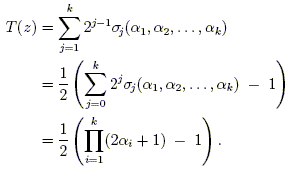 | ■ |
For example, 3142875 = 3 · 53 · 172 · 29 is the hypotenuse of exactly T(3142875) = ((2 · 3 + 1) (2 · 2 + 1) (2 · 1 + 1) – 1) / 2 = 52 Pythagorean triples.
Corollary Let z = Q p1 p2 ... pk > 1 be a natural number with exactly k distinct prime factors satisfying p ≡ 1 mod 4 and no factor of the form p2 for any prime p ≡ 1 mod 4. Then the number of Pythagorean triples with hypotenuse z is T(z) = (3k – 1) / 2.
| ![]() In fact, only one of these values for z holds. The solution
In fact, only one of these values for z holds. The solution ![]() results in x or y being negative, so we take
results in x or y being negative, so we take

![]() for r and for s, we find
for r and for s, we find












